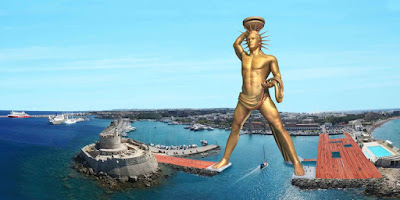Top 10 Historical Landmarks and Monumental Sites in Germany (you probably haven't heard before)
Germany is the fourth country in the world and fifth in Europe with the highest number of World Heritage Sites, behind Italy and Spain. While most people have heard of the "Brandenburg Gate", "Neuschwanstein Castle" or the "Berlin Wall Memorial" none of these monuments are on the list... So which sites make up the list of World Heritage Sites in Germany? Here we bring you a list of 10 sites of the total of 46 that are located throughout the territory of present-day Germany and that have been recognized by UNESCO for their historical heritage:
10. Palaces and Parks of Potsdam and Berlin.
The parks and residences of Potsdam and Berlin, two enclaves separated until 1990, radiate such splendid magnificence that they have been called the "Prussian Versailles". Today, reunited, they are probably the most eclectic concentration of 18th and 19th-century palace buildings and gardens in Europe.
 |
| Sanssouci Palace in Potsdam near Berlin |
9. Mines of Rammelsberg, Historic City of Goslar.
The Harz Mountains, located in the heart of Germany, are rich in forests with numerous game species. But in their bowels they harbor gold, silver, copper and zinc. It is therefore not surprising that the Rammelsberg mines on the western slopes of these mountains were already active in the third century before the Christian era. Rammelsberg is located 1 km southeast of Goslar in the Harz Mountains. Since the 3rd century B.C., metals, silver, copper, zinc and gold have been mined and produced. The important silver deposits were one of the main reasons why Emperor Henry II decided to establish an imperial residence at the foot of the mountain, even holding an imperial assembly in 1009. The monarch built a simple palace that was apparently destroyed by fire. His successor, Conrad II, began the construction of a new palace which was completed in the time of Henry III who made Goslar his main residence.
 |
| The pintoresque city of Goslar |
8. Castles of Augustusburg and Falkenlust in Brühl.
At the beginning of the 18th century, the construction of these two leisure palaces of the prince electors of Cologne marked the triumph of the Rococo style in Germany. The virtual absence of subsequent modifications has allowed Augustburg and Falkenlust to keep the splendid harmony of colors and forms dreamed of by their creators, among whom are some of the most notable figures of the European Baroque.
 |
| Castle of Augustusburg (Brühl, Germany) |
7. Roman Monuments of Trier.
Trier is an exceptional testimony to Roman civilization because of the density and quality of the monuments preserved from that period. Seat of emperors and bishops, what was once called "the Second Rome" still preserves the most remarkable collection of Roman monuments to be found north of the Alps. The Roman city was founded under the name of Colonia Augusta Treverorum between 41 and 54 of the Christian era.
 |
| The Porta Nigra ("Black Gate" in Latin) |
6. St. Mary's Cathedral and St. Michael's Church in Hildesheim.
The cultural renaissance that Germany experienced under the Ottonian dynasty had in the Saxon city of Hildesheim, thanks to the determined impulse of Bishop Bernward, one of its most thriving centers. The abbey church of St. Michael and the cathedral of St. Mary have remained as brilliant testimonies of a moment in which the powerful Roman artistic tradition was combined with Germanic and Byzantine influences to produce the first strictly European art in history.
 |
| St. Michael's Church in Hildesheim |
5. Speyer Cathedral.
Speyer Cathedral was for four centuries the pantheon of the German emperors, but it was also, after its reconstruction at the end of the 11th century, the first great fully vaulted church in Europe. It summarizes the power of the Holy Roman Empire at its peak and the rise of a new artistic style, the Romanesque.
 |
| Speyer Cathedral - One of the most prominent examples of Romenesque arquitecture |
4. Monastery of Maulbronn.
The Cistercian abbey of Maulbronn is the most complete and best preserved medieval monastic complex north of the Alps. The church, which straddles the Romanesque and Gothic styles, had a decisive influence on the spread of Gothic architecture in central and northern Europe.
 |
| Monastery of Maulbronn in Bayern, Germany |
3. Pilgrimage Church of Wies.
Miraculously preserved in a spectacular Alpine valley, the white church of Wies, masterpiece of architect Dominikus Zimmermann, is probably the most perfect expression of Bavarian rococo, exuberant, joyful and colorful.
 |
| Bavarian Church in the middle of the Alps |
2. Collegiate Church, Castle and Old Town of Quedlinburg.
Situated in an undulating region of the Harz Mountains, the "village Quitilingaburg" was first mentioned in 922 in an official document of Henry I the Fowler who built "the castle on the hill", the origin of this prosperous town in the Middle Ages that became the capital of the German empire of eastern Franconia.
 |
| The city of Quedlinburg is one of the most beautiful german cities |
1. Messel Pit Fosile Site.
Messel is the most important site for understanding life on earth in the Eocene, i.e. between 57 and 36 million years ago. It is providing unique information on the early stages of mammalian evolution thanks to the discovery of fossils in an extraordinary state of preservation, ranging from fully articulated skeletons to the stomach contents of animals from that period.
 |
| Photo of Darwinian massilae |
How did you find the list? Let us know in the comments section below :)
